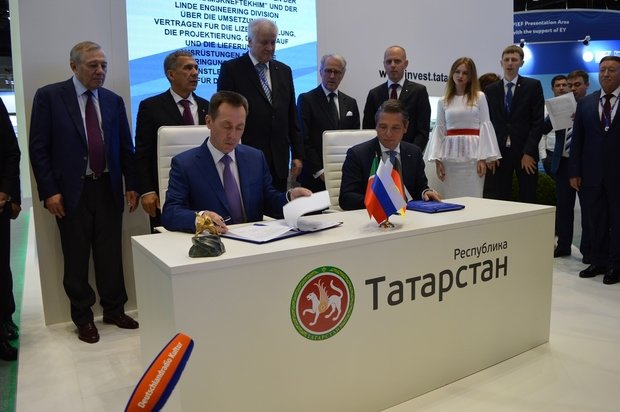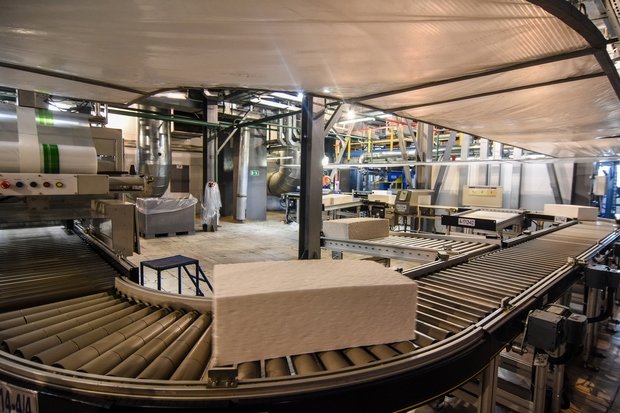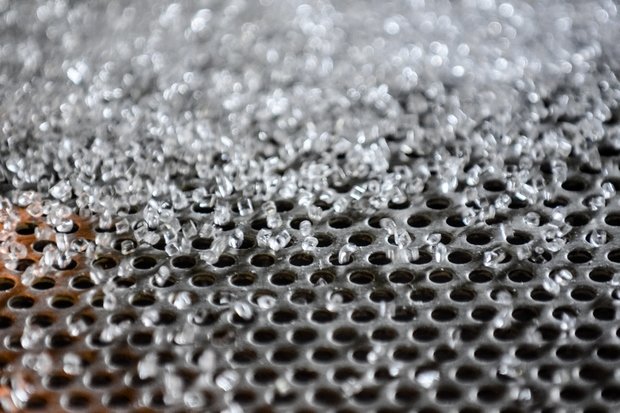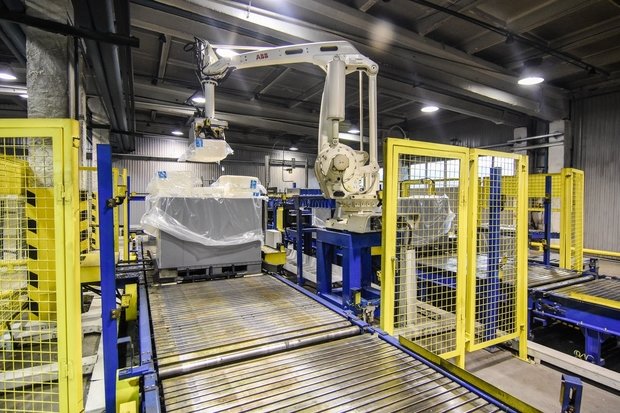Azat Bikmurzin: ''The olefin complex construction project will already enter an active phase next year''
After signing the basic agreement between Nizhnekamskneftekhim and Linde AG, the initial work stage in the olefin complex began. Now specialists of the German company are assessing the impact of the project on the environment and social sphere. Director General of Nizhnekamskneftekhim Azat Bikmurzin told about it in an interview to Realnoe Vremya online newspaper. The enterprise also actively performs other tasks. Increasing linear polyethylene sales is one of the goals for this year. The production volume can exceed scheduled 100,000 tonnes by late December. The interview tells how the import substitution programme is fulfilled and how the fall in automobile sales in China affected the demand for NKNKH's synthetic rubbers.
Mr Bikmurzin, the signing of the agreement on construction of an olefin complex is one of the main events of the year. Could you tell how the work on the project is going after signing the agreement and when the first stone will be laid, please?
In accordance with the agreement, nowadays Linde AG is assessing the impact on the environment and social sphere at the initial work stage. Compliance with requirements in ecology and issues of social responsibility is one of the compulsory conditions of the creditors to make a decision on financing.
Now we are considering different schemes. And the full configuration of this project will be defined in the short run. I think the olefin complex construction project will already enter an active phase next year.

As for rubbers, you expected a sustainable demand for synthetic rubbers and price growth for isoprene and butadiene rubbers this year. Are the forecasts true?
Indeed, our rubbers are in buoyant demand: production capacities are fully loaded, and there aren't remains in the warehouses except a usual working volume. Nizhnekamskneftekhim is an important supplier of the biggest foreign and Russian tyre companies within long-term agreements. And it is at least 75% of the total volume of products that were sold in the foreign market and provide us with buoyant demand. We make seven types of rubbers, in numbers, it's over 600,000 tonnes a year.
90% of synthetic rubbers are sent abroad. But at the annual meeting, it was told about the fear of slower automobile sales in China. Indeed, automobile sales in China have shown the lowest fall in two years. How did it affect the demand for synthetic rubbers?
Such a factor was really mentioned by us. Nevertheless, according to the China Association of Automobile Manufacturers' data, sales of all types of automobiles have increased by 4% in 7 months this year. Production of automobiles and lorries also demonstrates a rise of about 7%. Even a higher sales growth is expected, at 5%, considering the tendency in the Chinese market that has appeared in the last several years when sales fall in the first half of the year and the growth renews in the second half. Speaking about specifically automobiles, their production has grown by 3% in 7 months and sales – by 2%. This is why our fears are not confirmed.

If we're speaking about halobutyl rubber, how has the new factory in Near East affected the price?
As far as we're concerned, test supplies from this factory started in February-March. The volumes are not big now and they aren't able to affect the market. This factory's operation has rather a psychological effect. Consumers know that demand will increase.
One of the goals of NKNKH is to increase the sales volume of linear low-density polyethylene from 62,000 to 100,000 tonnes. Are you going to sell the product by increasing sales points or augmenting lots of the good for the current consumers?
The total volume of the Russian linear low-density polyethylene market was 285,000 tonnes last year. Nobody makes it in Russia except Nizhnekamskneftekhim PJSC. But we need to consider the high competition among Russian high-density polyethylene makers – in the Russian market, the production volume is equal to the consumption level, as well as active expansion of foreign opponents. Last year, Uz-Kor Gas with a capacity of 375,000 tonnes of polyethylene a year was put into operation in Uzbekistan. The kick-off of new SOCAR polyethylene factory in Azerbaijan is expected next year. The Russian market is premium for these enterprises. This is why now we need to do what others can't. We have a big reserve in import substitution from a perspective of both increase in sales volume for the current consumers and expansion of the market. And, by the way, we're going to reach a volume of over 120,000 tonnes this year.
70-75% of linear polyethylene is brought to Russia from abroad. Are local companies ready to buy the local product?
Last year the volume of imported products totalled 215,000 tonnes – it's 75% of the consumption volume. But this year we expect the import to considerably reduce. Numbers tell about the readiness of Russian processors to buy our linear polyethylene. In 2013, linear polyethylene production grew by 8%, in 2014 – by 12%, in 2015 – by 23%, in 2016 – by 35%. And this year we expect a more than 50% growth. In addition, all linear polyethylene is in demand among our partners.
What is the market coverage of NKNKH today? Most importantly, how much are you going to cover?
Of course, we can't cover the whole linear polyethylene market at once because the market has types that we haven't mastered yet for technological reasons. However, we see that we're able to account for over half of the Russian market including new types that we're mastering.
In general, does the rise of plastic production volume coincide with the demand in the Russian market?
There's an obvious fact: creation or increase of production of a good leads to the creation of new enterprises in recycling, diversification of the assortment of products and, consequently, to a higher demand. In the world of plastic, from a long-term perspective, an average consumption growth is 5-6% a year. Bigger recycling volume is right behind this growth. Sometimes cycles of production rise and consumption can be different, which can bring to a temporary deficit or surplus of products in the market. Nevertheless, they become equal in the long-term perspective.

What do you think of Nizhnekamskneftekhim's work in import substitution? Do you plan to manufacture any other analogues of imported goods?
We do a big job because the potential of substitution of imported plastic types in the Russian market is still very high. Production of polypropylene and polyethylene types is one of the significant areas. As for other types, certification of РЕ 6146КМ for insulation of gas and oil pipes continues. New types of polypropylene for the automobile sector that don't have analogues in Russia are produced and tested.
We deal with import substitution of some expensive raw materials, catalysts, components of catalyst systems and inhibitors. Specialists of our R&D together with the Institute of Heteroorganic Compounds created a concentrated triisobutylaluminum technology that was mastered in the Oligomer Factory. As a result, we stopped buying this expensive component of the catalyst system abroad in 2013.
As for inhibitors, we switched to Russian inhibiting systems in industrial water cycle to a great degree.
Work productivity at NKNKH has increased more than 10 times since 2003 while the personnel has been reduced by 22%. Could you tell how you managed to achieve it, please?
We managed to achieve it by constructing and launching new factories and augmenting capacities of the equipment. New factories making polystyrene, polypropylene, polyethylene, ABS plastics, rubbers, NdBR, BR, halobutyl rubber were built and put into operation.
A gradual augmentation and rise of capacities of acting factories manufacturing ethylene, propylene, styrene, propylene oxide, divinyl were carried out at the same time to provide the new factories with monomers. Now investment projects on construction of isobutylene and formaldehyde factories, technical rearmament of Isoprene Factory are fulfilled now. It will enable to increase isoprene rubber production to 330,000 tonnes a year. As a result, over 1,500 new working places were created. In addition, a scheduled work on the optimisation of the enterprise's structure was performed, the number of low productive workers was optimised. The people who did a difficult manual job by packaging rubber were substituted by robots. It all favoured such a growth of work productivity.

The first stage of modernisation of the biological treatment plants ended in late 2016. What are the advantages of the modernisation? When will the second stage begin?
Nizhnekamskneftekhim PJSC's attitude to environmental protection is special. Volumes of fresh water intake from the Kama River reduce, the volume of water that returns to the water cycle system constantly rises, measures aimed at improving the treatment grade of sewage water of industrial enterprises and the city are taken.
In 2016, works on the fulfilment of the first stage of reconstruction of the hub of mechanical sewage water treatment of biological treatment facilities ended. The second stage plans reconstruction of that part of the biological treatment facility where purification of the industrial sewage takes place. First of all, we need to consider the diversity and specifics of sewages that come for treatment from all enterprises of the industrial hub. This is why a scrupulous and detailed job on laboratory analyses and industrial tests of the offered technologies have been done this year. After the tests, the more effective technology of sewage water treatment and collection and neutralisation of exhaust fumes was chosen. The design documentation is created and equipment is selected for the chosen technologies. This year we also plan to end the creation of the design documentation to go through necessary expertise and start the second stage of reconstruction in 2018.
How much money does NKNKH expand on social projects? And which projects are the most important for the enterprise?
Nizhnekamskneftekhim actively works in the social sphere. In 2016, the company participated in the reconstruction of the Kama embankment and Holy Spring, repair of internal roads and roads in the industrial zone. It invested money in landscaping the Lemaev Square and entrance to the Ice Palace by its 50 th anniversary.
It is planned to send 700 million rubles to the Fund of Revival of Historical and Cultural Monuments of Tatarstan, recreation of the analogue of the White Chamber of the 14 th century in Bolgar – a hotel with bath complex, the Our Lady of Kazan Cathedral and Bolgarian Islamic Academy this year.
A lot of effort is put to support older people. Workers of the enterprise are granted loans and given financial support for different purposes – when a child is born; workers who bring up kids with disabilities; to purchase the essentials; financial support when workers retire. Over 300 million rubles are annually expanded on such payments within a collective agreement.